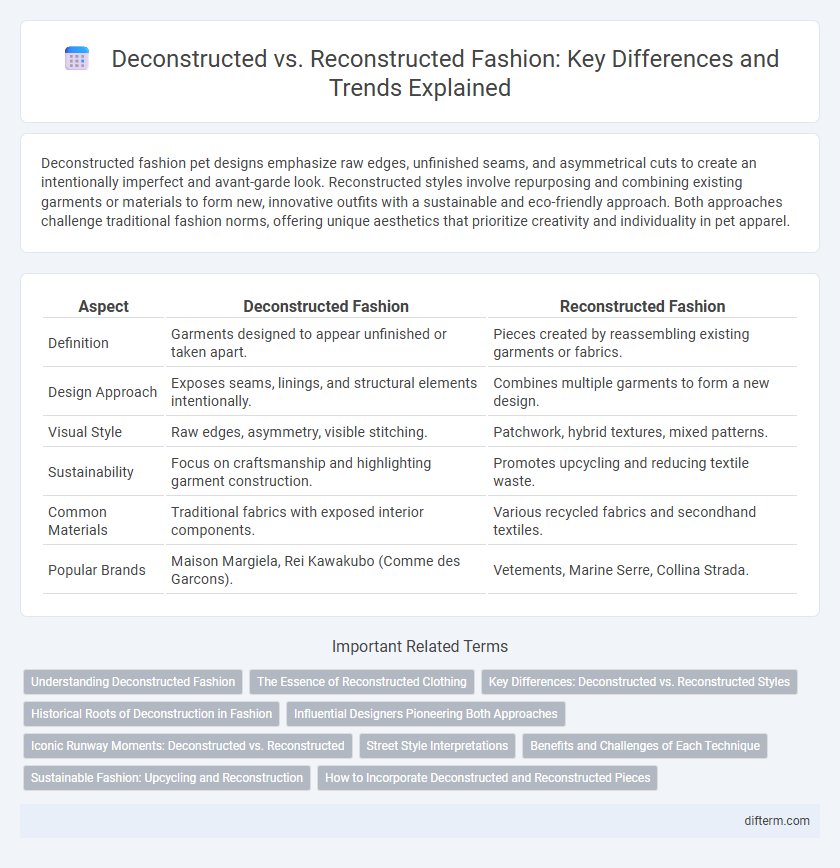Deconstructed fashion pet designs emphasize raw edges, unfinished seams, and asymmetrical cuts to create an intentionally imperfect and avant-garde look. Reconstructed styles involve repurposing and combining existing garments or materials to form new, innovative outfits with a sustainable and eco-friendly approach. Both approaches challenge traditional fashion norms, offering unique aesthetics that prioritize creativity and individuality in pet apparel.
Table of Comparison
| Aspect | Deconstructed Fashion | Reconstructed Fashion |
|---|---|---|
| Definition | Garments designed to appear unfinished or taken apart. | Pieces created by reassembling existing garments or fabrics. |
| Design Approach | Exposes seams, linings, and structural elements intentionally. | Combines multiple garments to form a new design. |
| Visual Style | Raw edges, asymmetry, visible stitching. | Patchwork, hybrid textures, mixed patterns. |
| Sustainability | Focus on craftsmanship and highlighting garment construction. | Promotes upcycling and reducing textile waste. |
| Common Materials | Traditional fabrics with exposed interior components. | Various recycled fabrics and secondhand textiles. |
| Popular Brands | Maison Margiela, Rei Kawakubo (Comme des Garcons). | Vetements, Marine Serre, Collina Strada. |
Understanding Deconstructed Fashion
Deconstructed fashion strips traditional garment structures to expose inner linings, seams, and raw edges, challenging conventional aesthetics and highlighting craftsmanship. This style emphasizes imperfection and asymmetry, creating innovative silhouettes that redefine garment construction. Designers like Martin Margiela and Rei Kawakubo pioneered this movement, making deconstructed fashion a symbol of avant-garde and experimental design.
The Essence of Reconstructed Clothing
Reconstructed clothing embraces sustainability by repurposing vintage fabrics and garments into avant-garde, wearable art that challenges traditional fashion norms. This approach highlights craftsmanship through meticulous handwork, patchwork, and asymmetrical designs, emphasizing individuality and eco-consciousness in modern wardrobes. Brands like Maison Margiela and Vetements exemplify the innovative fusion of past and present in reconstructed fashion, setting trends that prioritize creativity and environmental responsibility.
Key Differences: Deconstructed vs. Reconstructed Styles
Deconstructed fashion emphasizes unfinished edges, exposed seams, and asymmetrical shapes to challenge traditional garment construction, creating an intentionally raw and avant-garde aesthetic. Reconstructed styles involve dismantling and reassembling pre-existing garments or fabric remnants into new designs, showcasing sustainability and innovative craftsmanship. Key differences include deconstruction's focus on de-emphasizing garment completion versus reconstruction's emphasis on transformation and reuse within fashion design.
Historical Roots of Deconstruction in Fashion
Deconstruction in fashion traces its origins to the late 20th century, influenced by postmodern philosophy and designers like Martin Margiela who challenged traditional garment construction. This approach emphasizes exposing inner layers, unfinished hems, and asymmetry to disrupt conventional tailoring. The historical roots reflect a shift from pristine silhouettes to raw, fragmented aesthetics that question fashion norms and inspire contemporary innovation.
Influential Designers Pioneering Both Approaches
Influential designers pioneering deconstructed and reconstructed fashion approaches include Martin Margiela, known for exposing garment interiors to challenge traditional tailoring, and Rei Kawakubo of Comme des Garcons, who redefines silhouette and structure through unconventional reassembly. Belgian designer Ann Demeulemeester also blends deconstruction with poetic reconstruction, emphasizing raw edges and layered fabrics. These designers reshape contemporary fashion by questioning construction norms and pushing boundaries between destruction and creation.
Iconic Runway Moments: Deconstructed vs. Reconstructed
Iconic runway moments showcase the bold contrast between deconstructed and reconstructed fashion, with deconstructed designs exposing raw seams and asymmetrical cuts to challenge traditional silhouettes. Reconstructed pieces reinvent vintage fabrics and garments, merging past aesthetics with modern tailoring to create fresh, narrative-rich ensembles. Designers like Martin Margiela and Vivienne Westwood have famously blurred boundaries, turning these techniques into cultural statements that redefine contemporary style.
Street Style Interpretations
Deconstructed fashion in street style emphasizes raw edges, asymmetry, and exposed seams to create unconventional silhouettes that challenge traditional garment construction. Reconstructed streetwear involves repurposing and reassembling vintage or worn pieces into new designs that blend nostalgia with modern aesthetics. Both approaches highlight individuality and innovation, driving dynamic trends in urban fashion culture.
Benefits and Challenges of Each Technique
Deconstructed fashion emphasizes raw edges, exposed seams, and an unfinished look, offering designers creative freedom and a bold, avant-garde aesthetic, yet it often challenges wearability and durability. Reconstructed garments utilize repurposed materials and vintage pieces, promoting sustainability and uniqueness but requiring meticulous tailoring and potentially higher production costs. Both techniques push the boundaries of traditional fashion design while addressing environmental concerns and consumer demand for originality.
Sustainable Fashion: Upcycling and Reconstruction
Deconstructed and reconstructed fashion techniques prioritize sustainability by transforming existing garments into refreshed, wearable art through upcycling. Deconstructed fashion involves dismantling clothing to expose inner structures or repurpose fabrics, reducing textile waste. Reconstructed fashion reassembles these components creatively, extending garment life cycles and promoting eco-friendly fashion practices.
How to Incorporate Deconstructed and Reconstructed Pieces
Incorporate deconstructed and reconstructed fashion pieces by pairing asymmetrical blazers or raw-edge denim with minimalist basics to balance avant-garde aesthetics and everyday wearability. Layering deconstructed tops with tailored bottoms creates a dynamic contrast, while reconstructed garments, such as patchwork jackets, add texture and visual interest to monochromatic outfits. Styling with neutral tones and simple accessories allows the intricate details of these innovative designs to stand out effectively in contemporary wardrobes.
Deconstructed vs reconstructed Infographic

 difterm.com
difterm.com